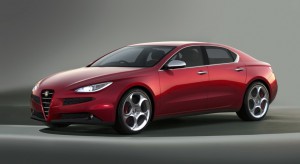
Alfa Romeo plans to introduce a new sedan in the U.S. as part of its plans to sell more than 100,000 vehicles here.
Italy’s Alfa Romeo will pull the wraps off its all-new Giulia sedan later today during a splashy event in Milan, the birthplace of the long-struggling brand.
The hoopla should be no surprise considering the critical role it will play in the promised revival of the Alfa brand, and in the broader success – or failure – of the strategy laid out for parent Fiat Chrysler Automobiles by CEO Sergio Marchionne.
Largely limited to the European market today, Marchionne wants to more than quadruple Alfa’s sales by 2018, with North America targeted to become one of the brand’s largest market After a long absence, however, Alfa is virtually unknown in the U.S. and Canada today, selling only a few 100 of its pint-sized 4C sports cars since making its return last year.
“Alfa Romeo’s goal of 400,000 units for the brand globally…and 150,000 U.S. sales by 2018 is ambitious,” said a new report from consultancy IHS Automotive. “The new midsize sedan Giulia will undoubtedly help Alfa significantly. The challenge—and stakes—might be most significant in the U.S. market, where the brand has almost no existing image in the eyes of U.S. consumers and no exclusive retail network.”
(Click Herefor a first drive of the Alfa Romeo 4C Spider.)
Marchionne and his senior management team outlined plans for the revival of Alfa in May 2014. And in a conversation with TheDetroitBureau.com earlier this month, Reid Bigland, the brand’s North American president and CEO, revealed FCA has already spent about $2 billion on the revitalization of Alfa Romeo, and it is committed to invest $4 billion more.
“We will crank things up” with the midsize sedan, promised Bigland, during an interview in Monterey, California, where he was presiding over a media drive of the Alfa Romeo 4C Spider. “It will give us a lot more mainstream attention.”
The Alfa plan has undergone a few tweaks since the 2014 announcement. For one thing, Alfa will no longer get a second small sports car developed as part of a joint venture between parent FCA and Japanese automaker Mazda – which is using its version as the new, 2016 MX-5 Miata. Instead, FCA will sell the new model under the Fiat badge.
Marchionne has now taken the position that “as long as I am CEO,” all Alfa Romeo products will be produced in Italy. The brand has strong ties to not just Italy as a whole, but Milan in particular, its very emblem bearing the snake and cross symbols that represented two of the city’s historic ruling families.
(Ralph Gilles, Chrysler’s head of design, named new styling chief for Alfa, as well. Click Here for more.)
While company officials have long stressed the importance of the new midsize sedan, they have been unusually secretive about its details, not even confirming it will pick up the long-familiar Giulia name.
The new platform has been dubbed the Giorgio, Bigland confirmed, and, unlike the carbon fiber 4C, sticks largely with conventional steel. It is expected to feature a multi-link suspension, offer a choice of both rear- and all-wheel-drive, and use a north-south engine layout.
As for the powertrain, Alfa is expected to have access to a range of new engines, both gas and diesel, from 2.0 liters up to a 3.0-liter V-6. There has been some talk that a small inline-four for the sedan might also become an option for the Alfa 4C which currently offers only a turbo 1.75-liter package.
Pricing for the sedan is expected to start somewhere above $40,000 when the four-door reaches the U.S. early next year as a 2017 model.
In its report, IHS Automotive warns that Alfa will have a tough challenge making a comeback. It has no image in the U.S. market today and not much more of one anywhere outside Europe. On the positive side, company officials say, they also don’t have to fight against the reputation for quality problems that drove Alfa out of the U.S. two decades ago.
But they will go up against an assortment of well-established luxury competitors with established showrooms and big marketing budgets who won’t welcome Alfa’s return.
“We have to be a cut above” the broader luxury competition, stressed Bigland, which means a heavy emphasis on performance. Alfa will emphasize emotional, rather than practical, factors, something readily apparent to anyone who has spent time in a 4C.
“It’s about image, it’s about performance,” he added. “It’s more ego-driven than the typical luxury car.”
While the little 4C planted Alfa’s flag back in the U.S., the new Giulia sedan will give it a nudge into more high-volume territory. It will soon be followed by a midsized SUV. Longer-term, a smaller ute and a compact sedan are certainties, according to insiders. And in keeping with luxury industry trends, few would be surprised to see Alfa offer some high-performance Quadrifoglio variants – its equivalent of the BMW M and Mercedes AMG lines.
(Alfa sibling brand Maserati hits the silk trail with fashion house Zegna. Click Here for the story.)

Nice looking car, except for Alpha’s Edseleque proboscis.
It’s going to be one mighty impressive car priced at $40K to save Alfa. I don’t see it happening with no sales or service structure in the U.S. even if the car is something exceptional for $40K.
It looks too much like the 200.
Loser
Those are fantasy sales projections for the U.S.